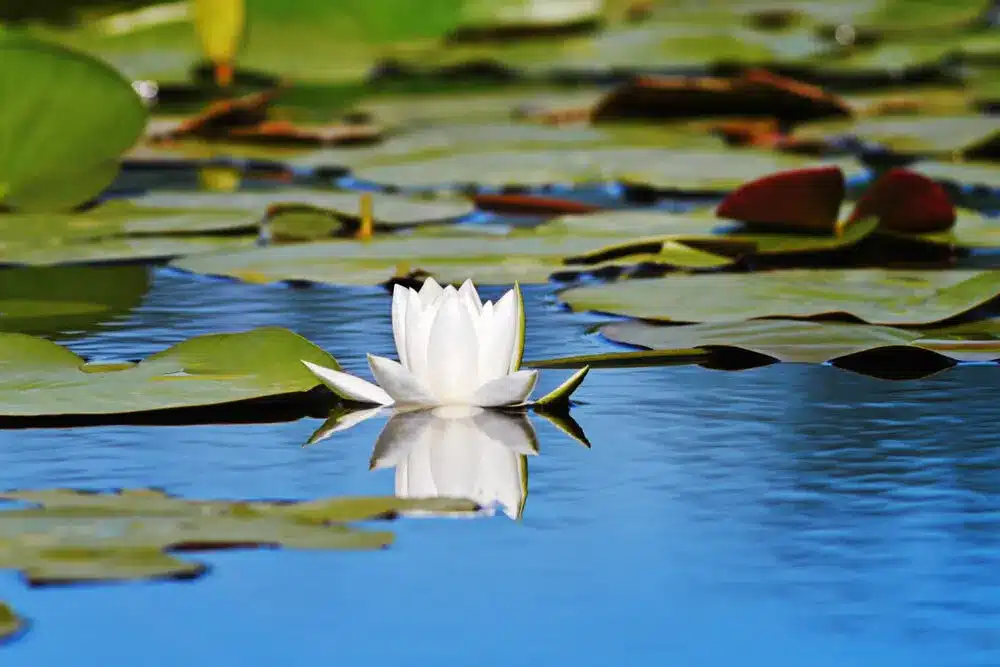Cuprins
The Danube Delta, one of the most beautiful and diverse natural areas in Europe, is a true botanist’s paradise, as its area is not only a sanctuary for numerous species of birds and animals, but also the ideal habitat for an impressive variety of plants.
The diversity of plants in this aquatic ecosystem is due to the unique environment here: flowing and standing waters, canals, flats, sand dunes and alluvial forests. The unique conditions favor the development of plant species adapted to a variety of habitats, each contributing to the ecological balance and health of the delta.
For the adventurous and eager to learn more, exploring the flora of the Danube Delta ultimately provides a better understanding of the complex interactions between plants and their environment, all the more so as each species here has its own story of adaptation and resilience.
In the following lines, we offer you a guide to the flora of the delta, to help you enter the plant world at the Danube’s mouth, to understand it, to protect it and to enjoy it as a rare and precious privilege.
- What types of plants grow in the Danube Delta
- Plants of the Danube Delta – types of trees
- Plants of the Danube Delta – aquatic vegetation
- Plants of the Danube Delta – rare species
What types of plants grow in the Danube Delta
The Delta presents the curious traveler with a remarkable botanical diversity and a varied geographical environment, which allows the coexistence of more than 1830 plant species.
Alluvial forests are one of the distinctive habitats of the Danube Delta. Located along the river’s arms and on islands, they consist of tree species that are well adapted to flood-prone soils and water level variations; they stabilize banks and create microhabitats for local fauna. The structure of these forests is complex, with an upper layer of tall trees and a dense lower layer of shrubs and herbaceous plants.
But more than forests, it is aquatic plants that give the delta its exotic character. Submerged plants, which grow completely underwater, are one of the main food sources for fish, while emergents, which have their roots in the water but whose upper parts rise above it, often form floating beaches or islands.
In the marshlands and on the drier islands of the delta, terrestrial plants adapted to the specific conditions occur. These plants are usually herbaceous and include species that can tolerate periods of flooding. They prevent soil erosion and are home to different animal species, essential for maintaining the ecological structure of the area.
Each category of plants and trees makes a unique contribution to the health and functioning of the Danube Delta ecosystem, demonstrating the adaptability and resilience of plant life to the challenges of a dynamic and variable environment. By getting to know them closely, you can better understand why it is necessary to protect them for future generations.
Plants of the Danube delta – types of trees
Although recognized for its reed and papura dominated views, the delta is also home to many species of trees, silent witnesses to the natural processes of adaptation and change. Here are some of them:
Willow
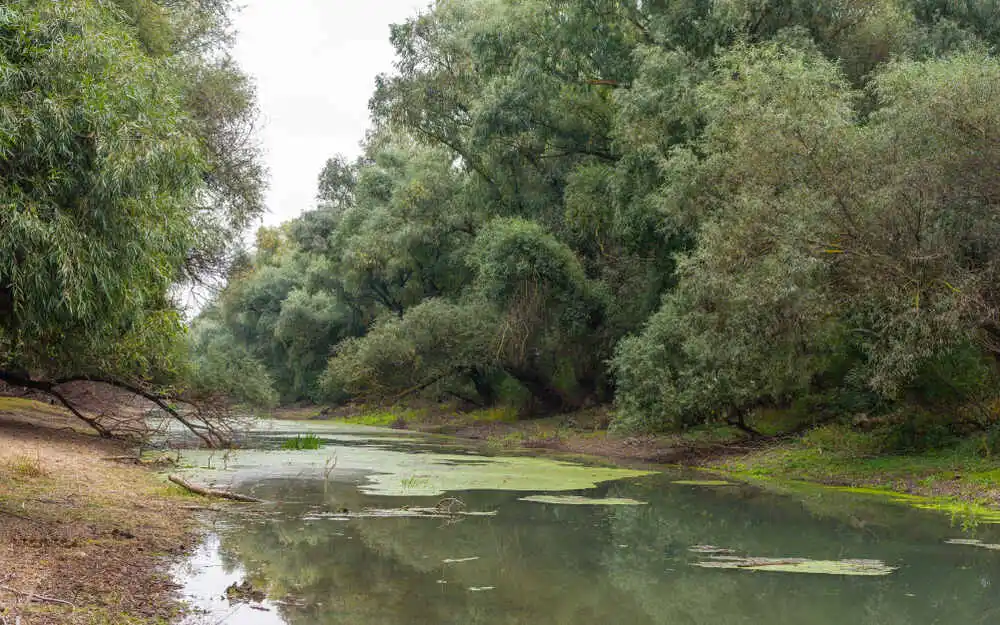
Willows on a canal in the Danube Delta
The willow is one of the most widespread trees in the delta. It prefers wet areas and is perfectly adapted to frequent flooding. It has extensive and flexible roots, which enable it to stabilize the banks of rivers and canals. Its elongated, narrow leaves and flexible branches are ideal adaptations to withstand strong water currents and strong winds.
Poplar
It is highly adaptable and can grow rapidly, quickly taking over newly formed alluvial soils. It has an extensive root system, which helps fix alluvial soils and prevent erosion. Poplars also provide nesting places for birds and shelter for small mammals.
Black alder
The Danube Delta is the only area on the European continent where this tree still grows. It has the unique ability to improve soil quality by fixing nitrogen in the atmosphere, thanks to a symbiotic relationship with Frankia bacteria living in its root nodules. Black alder has round, glossy leaves and its dark bark is often covered with lichens. Black alder wood is prized for its resistance to water and is traditionally used in construction and for making tools.
Frasin
It prefers well-drained soils, but can also tolerate periods of flooding, making it ideal for the special conditions of the delta. It has leaves with lanceolate leaflets and grayish bark, smooth at first and cracked with age. This tree is ecologically important, providing food and shelter for many living things.
👉 When you want to get acquainted with the beautiful vegetation of the Delta, you need a place to rest after your excursions and relax in peace. At Green Dolphin Camping, we have prepared you accommodation in cottages equipped with the bare essentials, free Wi Fi, a small patio and private entrance, so you can feel at home.
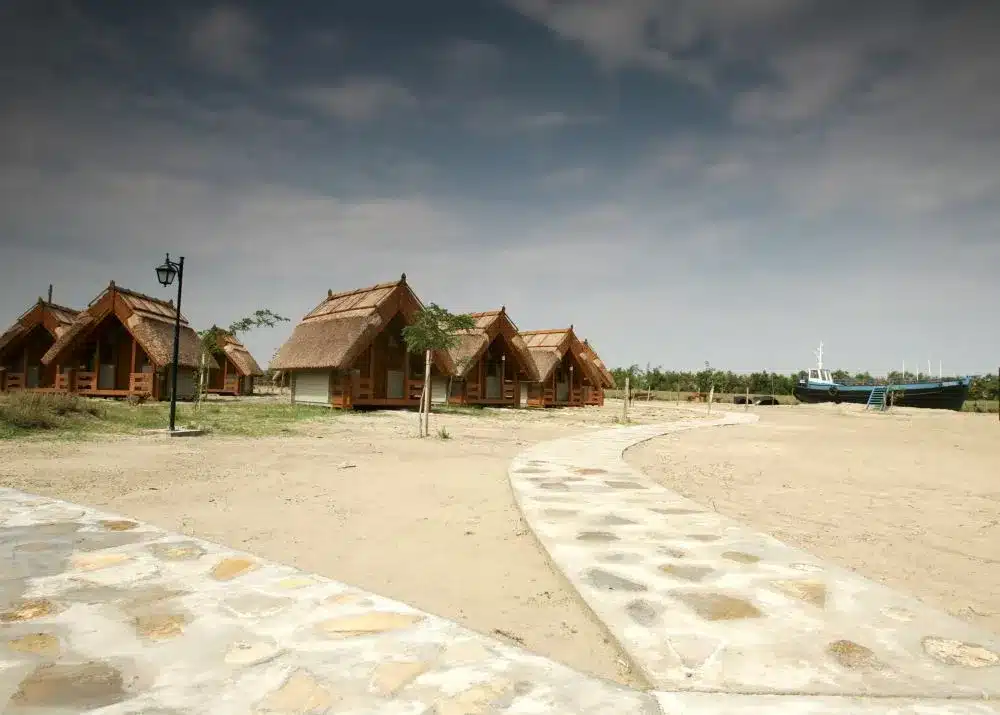
Green Dolphin Camping
Plants of the Danube Delta – aquatic vegetation
In addition to the beauty of their flowers, the aquatic plants of the delta’s aquatic plants oxygenate the waters, keeping them viable for underwater fauna. The moist environment here has led them to develop unconventional feeding mechanisms that are different from other plants. The most common and spectacular of these are:
White water lily
It is one of the most emblematic and recognizable aquatic plants of the Danube Delta. It has large, round leaves that float on the surface of the water and large, white flowers that open during the day and close at night. Its submersible rhizomes are well anchored in the muddy substrate of lakes and canals, contributing to sediment stability. Its flowers are spectacular and essential for pollinators. It plays an important role in water filtration and provides shelter for many species of aquatic organisms.
Yellow waterlily
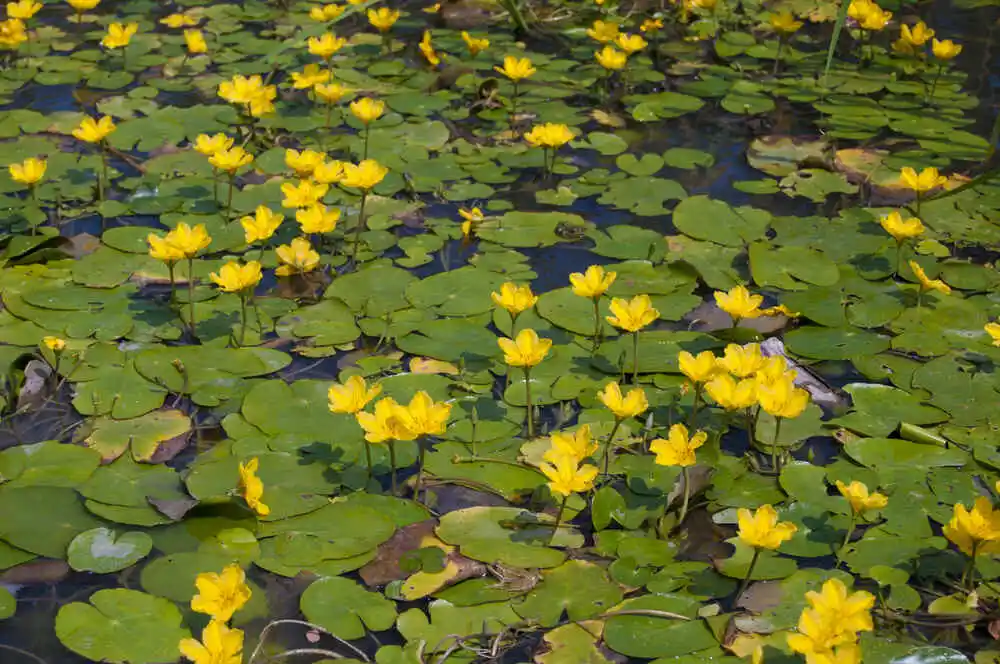
Yellow water lilies in the Danube Delta
Also known as water lily or yellow water lily, this plant has leaves similar to white water lily but more elongated, and the flowers are yellow, cup-shaped, floating in the water. The yellow water lily prefers shallower water and is remarkably resistant to changes in water level. Its flowers attract many insect species, and its leaves provide shelter and feeding sites for all kinds of fish and other creatures.
The pond weed
It is a perennial with bright yellow flowers and long, narrow, grass-like leaves. It prefers damp areas, the edges of lakes and can tolerate both standing and flowing water. Pond pondweed helps stabilize banks and helps filter water through its dense roots. Its flowers are highly attractive to pollinators.
Duckweed
Widespread in most places with standing water, lily is one of the simplest plants in the Danube Delta. It has very small leaves, which float on the surface of the water, and reproduces rapidly by vegetative division. It forms dense mats on the surface of calm waters, helping to reduce evaporation. Although small, it plays an important role in the ecosystem, serving as food for fish and water birds and contributing fully to the nutrient cycle in the water.
Floating fern
It is a floating aquatic fern commonly found in the Danube Delta. Its leaves are small, oval, arranged in pairs and covered with fine hairs that help the plant to float. The goldweed forms dense mats on the surface of the water, reducing light reaching the water and thus controlling algae growth. It plays an important role in the aquatic habitat, providing shelter for insect larvae.
Utricularia vulgaris
Also known as puddle weed or water weed, it is a fascinating plant because of its feeding mode, adapted for trapping and digesting small aquatic organisms. The fine, submerged leaves are equipped with sac-like structures called utricles, which act as a trap for small invertebrates in the water. The bladderwort helps to control populations of small aquatic organisms and enriches the soil with nutrients when it digests captured prey.
Aldrovanda
A rare and legally protected carnivorous plant, also known as the water-wheel because of the shape of its twigs, which are arranged like the spokes of a bicycle wheel, the aldrovanda has no roots and floats freely in the water. The leaves are veritable traps, which close quickly when their prey – aquatic insects and small crustaceans – touch them. It thrives in nutrient-poor waters, and its ability to feed on living organisms helps it to supplement its nutrient requirements.
👉 Many of the Delta’s rare plants can be found in secluded spots among the flats. If you want to enjoy their beauty and collect memories to last a lifetime, we offer boat trips that will take you along the charming channels of the Delta, among water lilies and water hyrids.
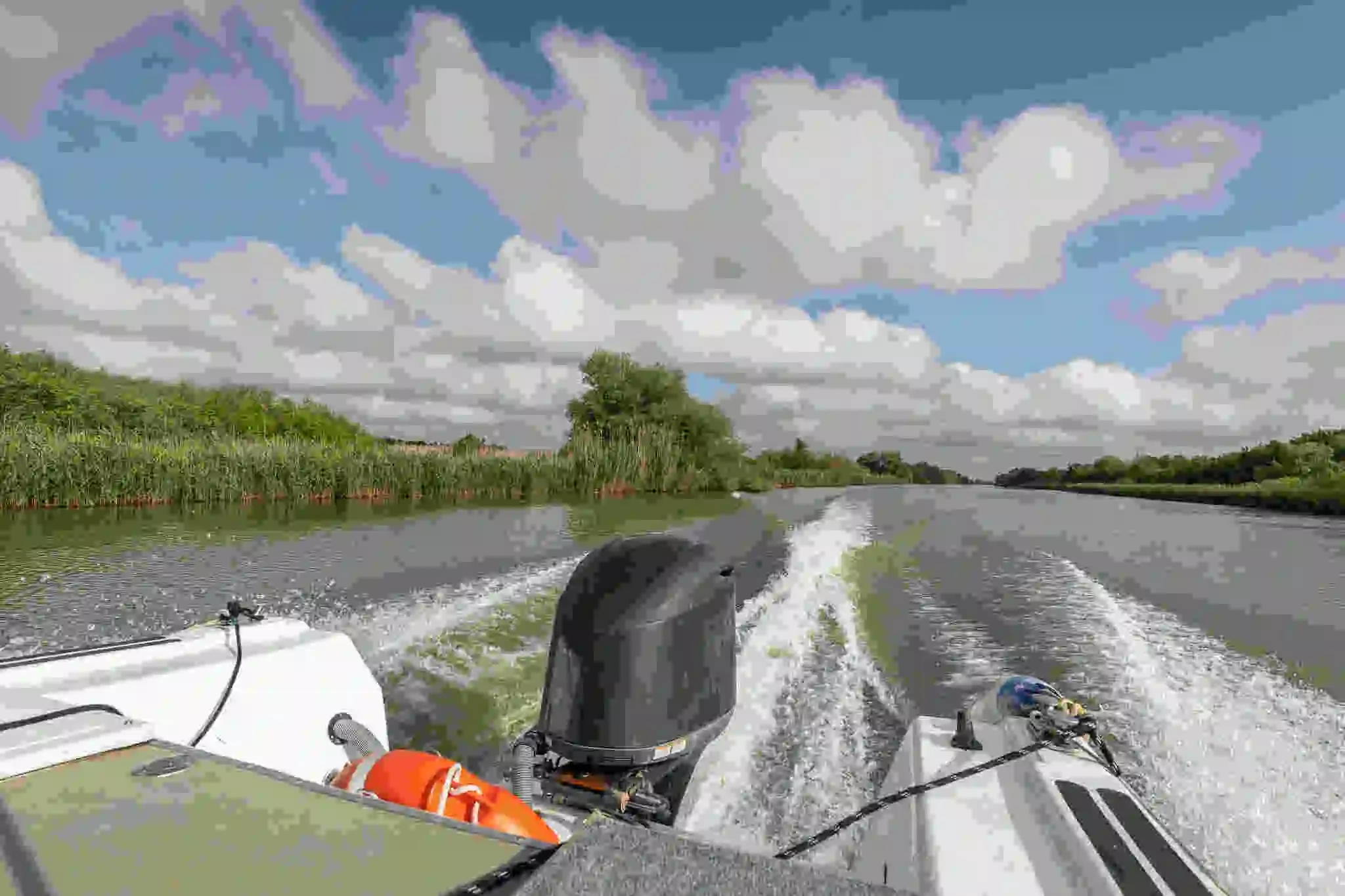
Boat trip, Green Dolphin Camping
Plants of the Danube Delta – rare species
Greek ivy
Native to the Mediterranean, the Greek ivy is a climbing plant found in the delta’s ditches and forests. This liana shrub is known for its long, flexible stems, which can reach up to 15 meters in length, clinging to trees and other structures to reach sunlight. Its leaves are opposite, elliptic and glossy, and the small, stellate flowers are brownish or dark purple.
Wild vanilla
Native to the Americas, wild vanilla is a perennial plant that grows in the sandy and salty areas around Sulina or in the Letea Forest. It is well-adapted to nutrient-poor soils, with the ability to thrive in high salinity conditions.
Water thistle
It is an aquatic plant found nowhere else in our country. The small, white flowers appear in summer and are followed by large, thorny fruits containing edible seeds, which can be used to make salads or smoothies, much appreciated by the locals.
Solanum Nigrum
Related to the common potato, the plant occurs naturally in South Africa. In Romania, the only place it can be found is in the Danube Delta, especially in the sandy areas of Caraorman, Sfântu Gheorghe and Letea Forest. Unlike other plants brought in from different parts of the world, the larch is not considered an invasive species. The delta species, Solanum retroflexum, should not be confused with another variety, Solanum nigrum, which grows throughout the country.
👉 You can find out more about the beautiful area where the Danube meets the sea in our article Curiosities and general information about the Danube Delta.
The Danube Delta is a natural treasure for Romania and Europe and a haven of plant biodiversity. The plants that thrive in this unique ecosystem are adapted to the varied conditions of the Delta and many of them cannot be found anywhere else in the country or on the European continent. That’s why, when you visit the Delta, you should not forget these little plant wonders of nature and be captivated by their beauty and originality.
Photo source: Green Dolphin Camping, Shutterstock, Shutterstock, Shutterstock

